by Editor | Jul 31, 2017 | Ecotourism, Products
Article and Photos by Gary Cox
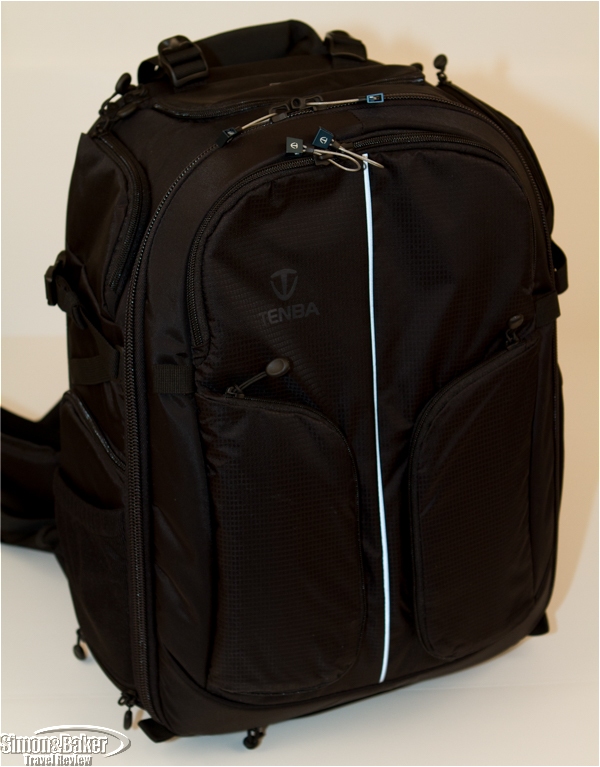
The Tenba Shootout Backpack 32L
Planning camera gear for an extended trip to Africa with location changes every two or three days starts with a solid transport solution. I don’t like anyone carrying my equipment, figuring that if someone is going to break stuff, it should be me. For my most recent trip, I chose the Tenba Shootout Backpack 32L (Tenba, 75 Virginia Road, North White Plains, New York 10603, +1 914 347 3300, www.tenba.com, info@tenba.com), and returned home happy with the decision and the performance of the bag. This is not a general purpose pack with some foam dividers stuffed into it, this is a backpack purpose built from the ground up for the photographer on the go.

My backpack has shoulder straps and a padded belt to distribute weight to the hips when worn.
The exterior of the backpack was made from water repellent twill and gray rip stop nylon. The interior compartments were built with rip stop nylon and soft tricot fabric, padded with perforated foam to minimize weight (six pounds empty). The center of the bag is for camera storage and featured water resistant pockets on the panel for storing memory cards and small items. It has full height pockets, one large on the front and one on the side for thin items. The other side has a half height pocket and an opening into the main chamber for quick access to a camera without unzipping the entire bag. There are some small organizing pockets on the front for miscellaneous items.

The padded handle allowed me to carry the load comfortably.

The side pocket gave me access to the main compartment and had a mesh pocket to store small items securely.
Near the handle on the top, there is a solid compartment to store fragile items. During the trip the compartment kept my sunglasses from being crushed. There is also a set of straps and a harness to attach a large tripod on the outside of the bag. A zippered compartment on the bottom holds a waterproof cover that can be pulled up over the bag like a little raincoat to keep it dry. Between the main compartment and the padded back brace and frame, there is a slot for a laptop or tablet. The zippers to the main compartment and front pocket can be locked with a small padlock, not included. The backpack, made in China, came with a small microfiber cloth and memory card wallet.
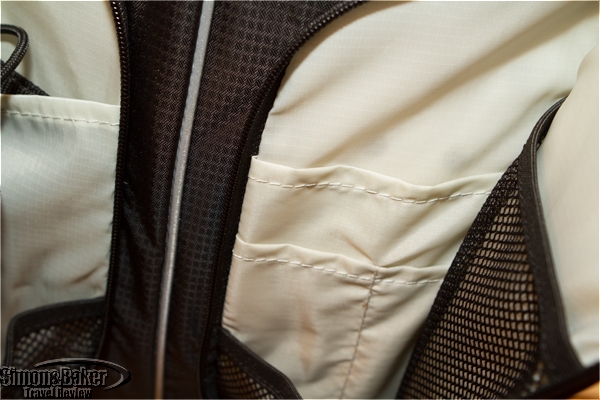
Opening the front pockets revealed more pockets for small items.
On safari trips to gather data on properties for the Simon and Baker Travel Review, I cannot afford to have any gear sidelined, so redundancy for key items is critical. On one trip, my wide angle lens bumped into the iron plating on the game viewing vehicle and broke. Apparently these are not in high demand for the average traveler in Botswana, and it was several days before I could get a replacement lens. I learned multiple lessons, pad everything during transfers and carry spares. The next challenge is the variety of shooting situations and the volume of photos I take. My go-to lens for general wildlife photography is the Canon 100 to 400 millimeter. It is versatile and a reasonable trade-off between weight and capability. On this trip, I included a 70 to 300 millimeter lens with the backup camera body.
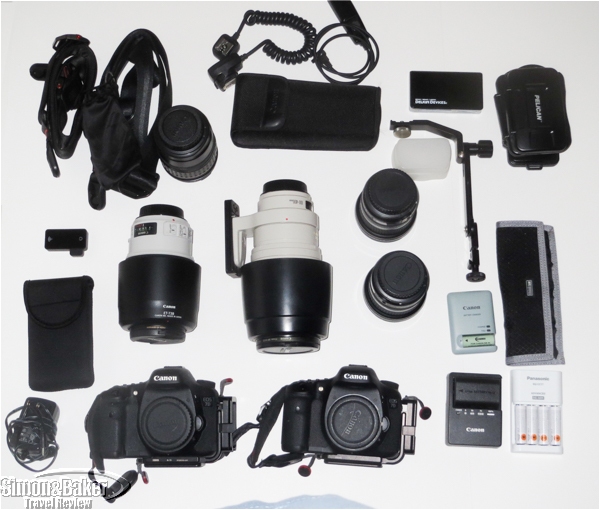
The camera equipment for our trip to Africa
I laid everything out before packing and started to wonder if the pack came in a larger size. Two camera bodies (Canon EOS 7D), two telephoto lenses, two wide angle lenses and a 28 to 130 millimeter for general purpose shooting. Flash, straps, batteries, chargers, memory cards, special purpose filters, macro adapter lens, cleaning supplies and iPad rounded out the final mix. It was a little tight, but everything fit and was well organized thanks to the bag’s dividers and pockets, including the handy well at the top for my sunglasses and mp3 player. With this load the backpack weighed over 30 pounds.
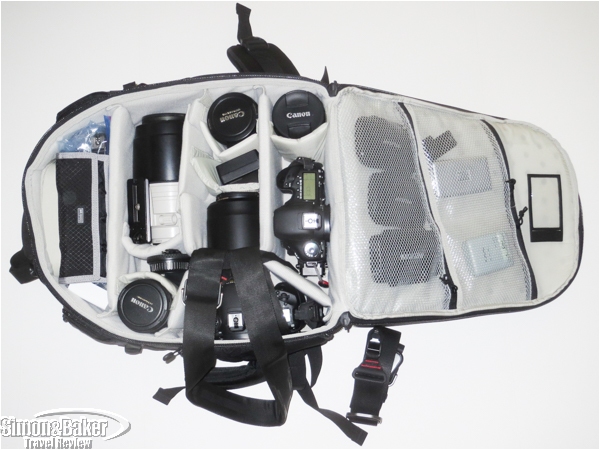
The main compartment held most of the camera gear
The fully loaded pack was comfortable to wear and distributed the weight across my shoulders and back. I am not a small guy and the straps had plenty of length, something I often find deficient in camera packs. The handle on the top of the bag was sturdy. The loaded pack rested upright and did not fall over when I set it on the ground. The padded belt could be a little annoying when I placed the bag into a cabinet or closet, but when I wore the backpack it was a godsend for balance and load distribution.
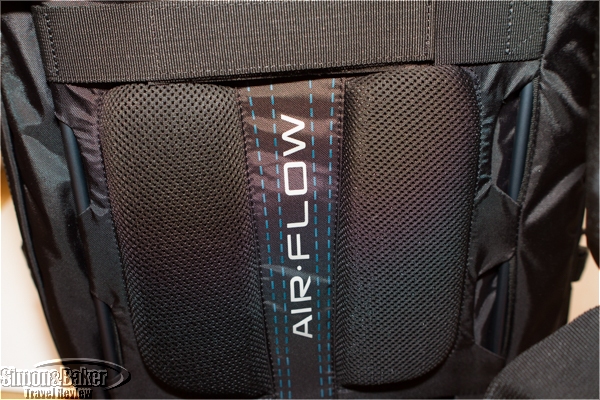
The Tenba Shootout Backpack 32L is padded and has a built in frame for stability.
The side of the bag has an easy access pocket to pull out a camera, but I never used that feature because my gear was too snug in the pack. I liked that the bag had lots of room for small things. It made it easy to keep organized. I used the pockets inside the main compartment for most of the memory cards and other valuable items. The outer pockets were handy for quick access, and ended up full of things I picked up when changing locations and then tidied away once we had rooms again. The tall side pocket was just right to hold my travel tripod. For the long haul flights I packed it away and only used the side pocket feature when changing properties in country. The zippers had nice easy to grab attachments and none of them became jammed or stuck.
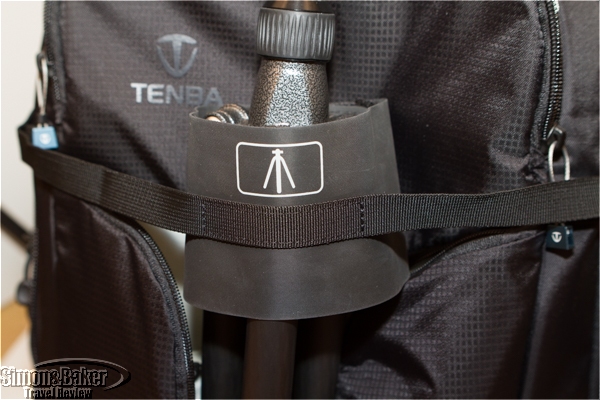
A strap allowed me to attach a tripod to the outside of the backpack.
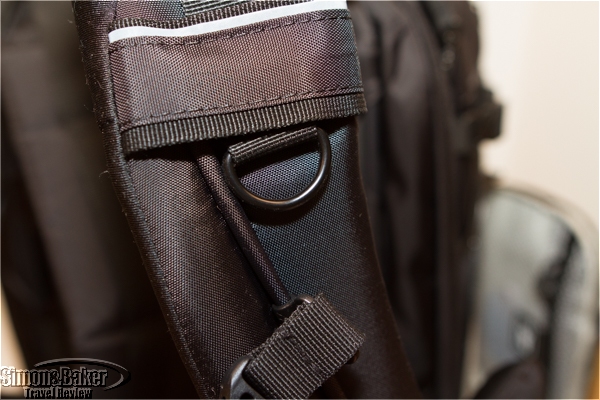
There were rings to attach external items on the shoulder straps
The bag held up well in extreme and varied conditions. For example, for the first 10 days we had intermittent rain and many opportunities to get muddy. The other three weeks were dry and dusty with a total of 12 property changes on planes, cars, vans and open safari vehicles. Everything inside my bag stayed safely clean and dry the entire time, and backpack arrived home looking new in spite of the opportunities to get muddy and dusty in the field. While pushing the luggage cart to the car in the parking lot at the airport at the end of the trip, the cart jammed solidly into a grating and the camera backpack flew off the top of the pile of bags landing on the parking lot surface. I assumed that a five foot forward flight and a four foot drop onto concrete would mean something was broken, but when I opened it at home, nothing was cracked or damaged. I would not recommend testing the backpack in that way, but it was good to know that when I let my guard down, the bag kept the contents unharmed. The Tenba Shootout Backpack 32L is my new choice for an expedition backpack to keep my gear safe.
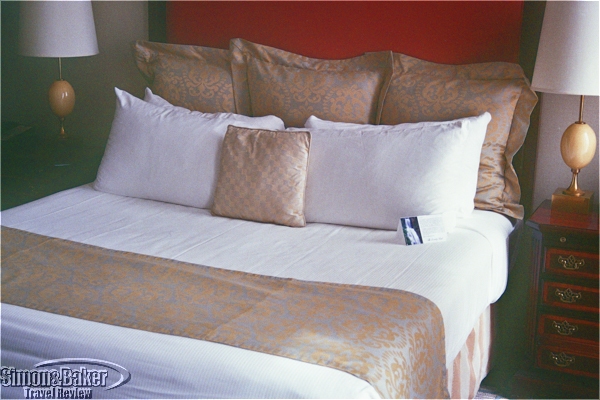
by Editor | Jul 17, 2017 | Accomodations
Article and photos by Scott S. Smith
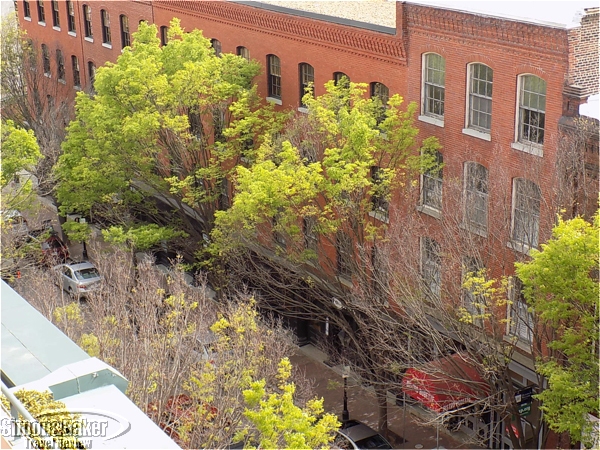
View from the top floor of The Berkeley Hotel in the restored tobacco warehouse district of downtown Richmond, Virginia
My bride, Sandra Wells, and I wanted to take our April 2017 honeymoon somewhere we could indulge our interest in history. We had never been to any of the sites related to the American Civil War and looked for the best place to learn more about that darkest of periods in our history. Atlanta had surprisingly little to offer, Gettysburg and most other battlefields were remote and focused just on local events, while we wanted to get a good overall understanding of the period. We came to realize that by far the best destination for this was Richmond, Virginia, around which dozens of battles were fought, since the capital of the Confederacy was just 109 miles south of Washington, D.C.
After consulting reviews and talking with experts in local tourism, we decided to spend two of our four nights at a 55-room luxury boutique hotel in the restored historic tobacco warehouse district in downtown Richmond, The Berkeley Hotel (1200 East Cary Street, Richmond, Virginia 23219, 804-780-1300, 888-780-4422, www.berkeleyhotel.com, info@berkeleyhotel.com). Downtown is just nine miles or 15 minutes from Richmond International Airport. It was built in 1988 by the Dobbs Family and prices were remarkably low for a four-star property (discounted because of ongoing renovation).
The Berkeley was set on the western edge of Shockoe Slip, whose cobblestone streets were a reminder that it was where the city started, and near the Central Business District. The hotel was an easy walk to the James River, where the American Civil War Center was located, and to the State Capitol, where the hemisphere’s oldest active legislature met (Richmond became the colonial capital in 1780; five years before, in a nearby church, Patrick Henry had given his speech with the famous phrase, “Give me liberty or give me death”).

The bed in our King Terrace View Room
The hotel assigned us a 300 square feet (27.8 square meters) King Terrace View Room on the top (sixth) floor. It had a balcony furnished with chairs to look out over the restaurants and stores that had breathed new life into the historic district. I’m not one to notice much about room décor, but there were lovely framed prints of flowers on the walls. We soon learned that many guests like to return to see how their new room is decorated because each was designed differently from all the others in carpeting, wallpaper, furniture, and even shape (there was a photo gallery on the website to compare some examples). The air conditioning and heat controls were easy to use and effective. The closet contained two terry cotton robes, an iron, and ironing board. There was a safe at the front desk.
The bed was very comfortable, with 100 percent Frette Italian linens, while the pillows were filled with down and feathers. The room was clean and we allowed cleaning once during our stay (it was normally once a day) and refused turn down service. We agreed to the hotel’s default policy of reducing impact on the environment by changing the linens every three days. Rollaway beds were available for an extra charge.
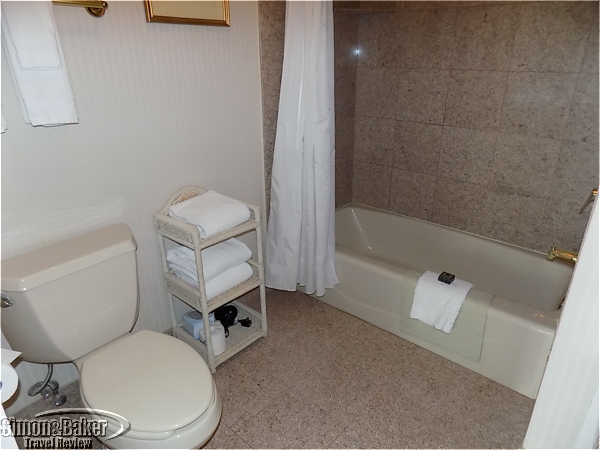
The bathroom in Room 604
There was a combination bathtub and shower with a powerful hydromassage showerhead. Like virtually every other luxury hotel we’ve been in, it had a makeup mirror with moderate (inadequate) lighting. There was a single sink, with toiletries from Gilchrist and Soames and cucumber and acai berry soap on the counter. The most unusual item was dental rinse (not something we normally have seen and helpful when dealing with flight liquid restrictions). There were two telephones, by the toilet and by the bed (local calls were free).

The desk and television side of the room
There was a coffee maker in the room, but we preferred to go to the lobby at 6:30 a.m. weekdays for fresh-made coffee, 7:00 a.m. on weekends (sweeteners included the best alternatives to sugar, stevia and erythiritol, which we have not seen often even in top hotels). There was also a desk and a 32-inch flat-screen LG television with cable. On the other side of the room there was a sitting area with stuffed chairs and a small round table.
There was complimentary high-speed wireless in the room and some public areas. There was no mini-bar or refrigerator, but ice machines were one floor below and elevators were fast (in a small hotel, that made transfers to other floors almost instantaneous). Complimentary health club privileges were available at the nearby Young Men’s Christian Association (YMCA). Children were welcome and the hotel was pet-friendly, charging $50 per stay, one per room up to 25 pounds.
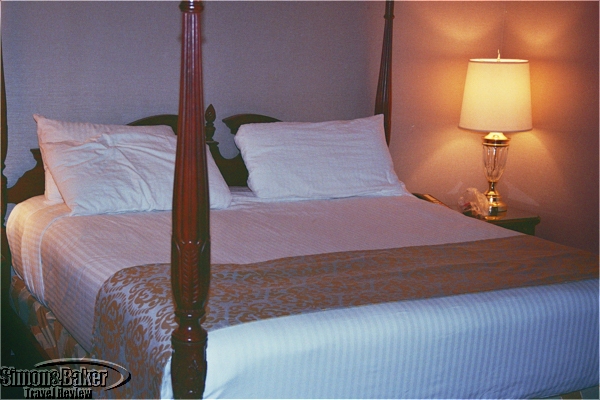
Our bed in the Governor’s Suite
Any hotel can create a nice environment with upscale carpets, décor, and furniture. Under normal circumstances, adequate training may produce good service. But a crisis highlights staff’s ability to balance conflicting demands from customers. On our first night at The Berkeley, we were asleep when around midnight we were awakened by a party next door. We asked them to keep it down, but when people get drunk they have a hard time judging whether they might be disturbing others. We finally called the front desk and within minutes a security representative invited us to move to Room 608 before he dealt with our neighbors. This seemed prudent: in our experience, most hotels prefer to start by asking guests to not disturb others, which usually just drags out the resolution. We had barely unpacked, so it was an easy move down the hall.
We were surprised when the new room turned out to be the Governor’s Suite, a pair of rooms behind a set of doors separating them from the rest of the top floor. The bedroom was 600 square feet (55.7 square meters) and had a 37 inch flat screen Philips television. Next to it was a Keurig coffee maker with Royal Cup and Green Mountain options. A three-panel full-length mirror stood in one corner. There were several sofa chairs around a low glass table and plenty of room for a small group to visit after a wedding (which is what the Suite was often used for, as well as for birthday celebrations and other special events; the adjacent room we just peeked into was for the reception or a dinner). The four-poster bed had two mattresses, which made for comfortable sleep. The Suite was rented the next night, so we returned to 604 in the morning.
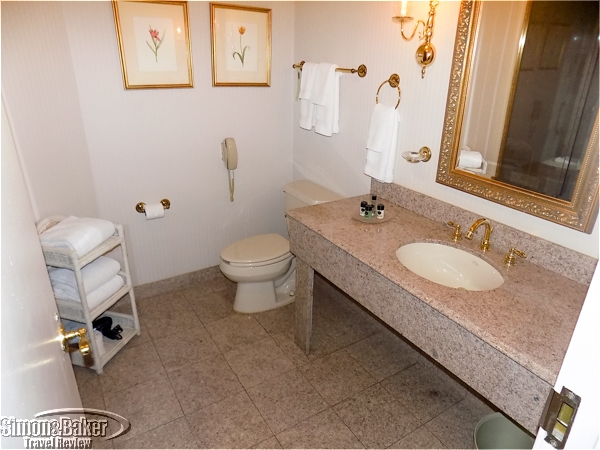

The bathroom in the Governor’s Suite
The bathroom in 608 was larger than 604, the single sink had more counter space, and the décor was nicer (large gold-trimmed mirror and lights). There was also a large walk-in shower, rather than the small tub-shower combo in 604.
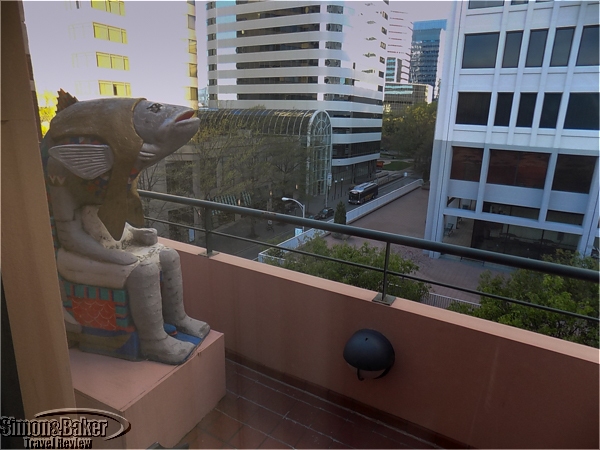
The view from the Governor’s Suite
There was a balcony with chairs outside 608 and a sculpture of a fish-headed, Egyptian-style god. The view was of the Central Business District.
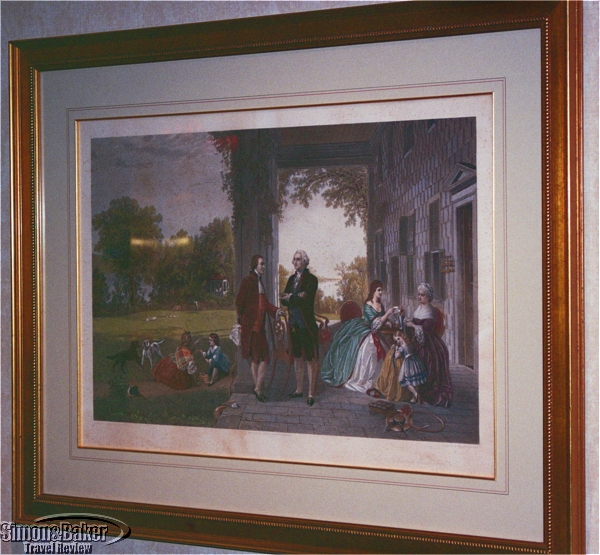
Artwork in one of the hotel hallways
The rooms and hallways were decorated with prints of paintings from the colonial era and old maps, which made it seem a place of Southern elegance from a bygone time. Many on the 60 staff of the hotel spoke Spanish. The ones we spoke with were knowledgeable about the city when we asked questions.
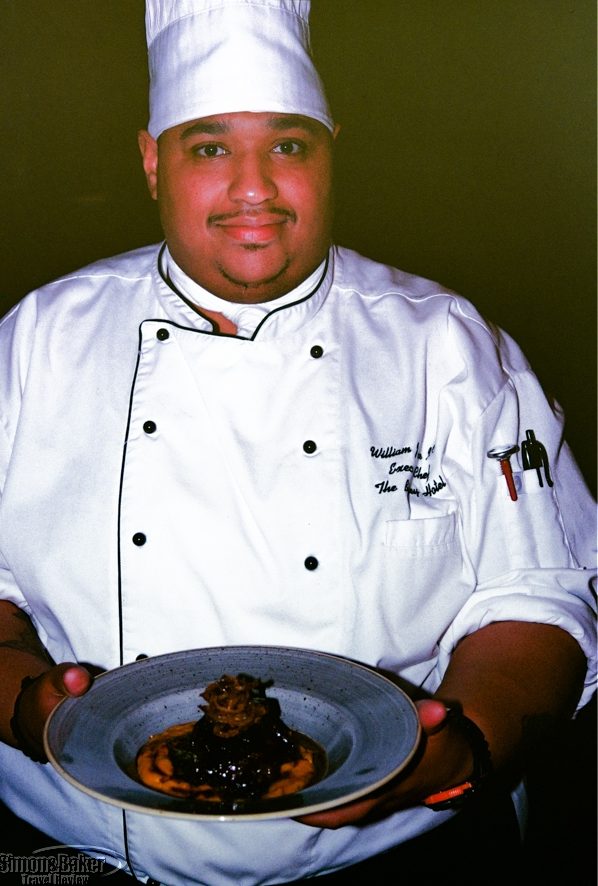
William Price III, chef, The Dining Room
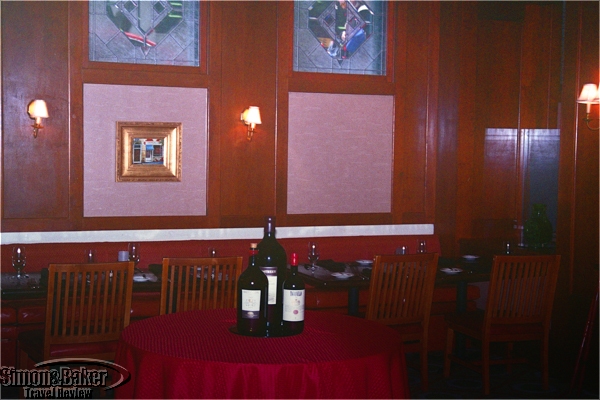
The Dining Room at The Berkeley
Breakfast, lunch, and dinner were served on the ground level in adjacent rooms, with a bar in the middle at the main restaurant, The Dining Room. William Price III, the young and friendly chef, had studied at the Pennsylvania School of Culinary Arts and Le Cordon Bleu Institute’s Pittsburg campus.
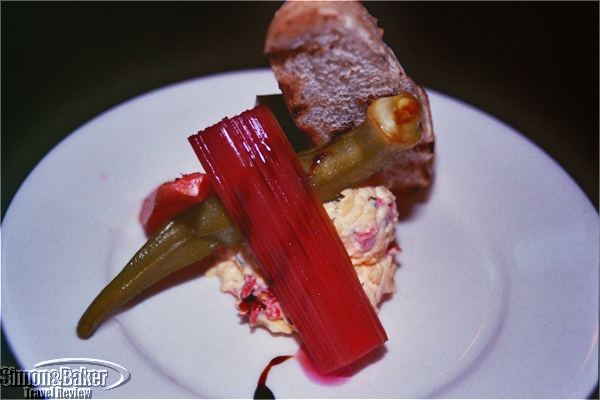
The Dining Room’s Amuse Bouche
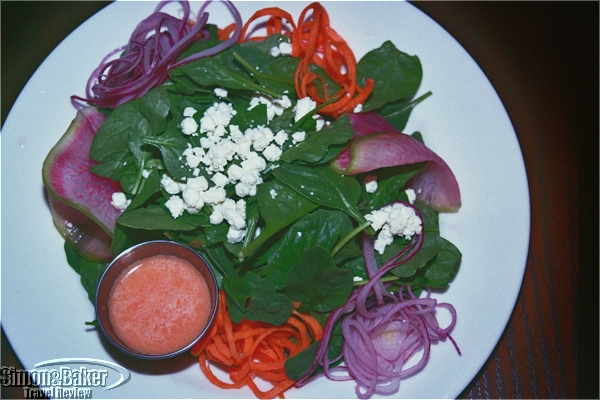
A salad at The Dining Room
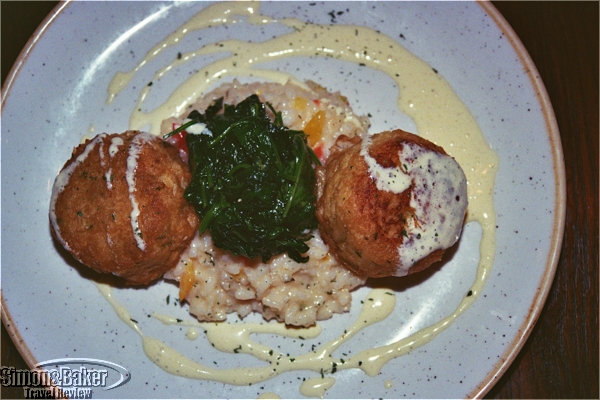
The chef’s Signature Southern dish
We enjoyed our breakfast, including the Signature Farmers Market Quiche, grits, a three-egg omelette with aged cheddar cheese, onions, and sautéed mushrooms, the Southern specialty fried green tomatoes, and a salad. There wasn’t a vegetarian option on the dinner menu. While Chef Price was whipping up a meatless experiment he had been working on, we amused our palettes with the Amuse Bouche, an appetizer of grilled French baguette, pimento cheese, and pickled vegetables, with sorghum balsamic vinaigrette, an apple peach crisp, and bread pudding. The chef’s Signature Southern, a tentative name, was a delicious concoction with five green tomatoes, Parmesan cheese, and sautéed spinach risotto.
We only had time to see the top priorities on our list in three days, including the Virginia Fine Arts Museum, the American Civil War Center, the Museum of the Confederacy, and the Black History Museum and Cultural Center (we also recommend the RVA Tour of the city over alternatives because of their extremely knowledgeable guides). Richmond was rich with culture, so we definitely want to return, and would stay at The Berkeley because of its location, comfortable beds, food, service, and price (we hope it remains a relative bargain when the renovation is complete).
by Editor | Jul 3, 2017 | Products
Article and photos by Gary Cox

Lounging on the porch with my iPad and the RoamingMan hotspot in the Thornybush Nature Reserve
On our most recent safari trip to South Africa we took a 353 gram RoamingMan (RoamingMan, Ucloudlink (America), Ltd, 119B Hester St, New York, NY 10002, www.roamingman.com, supportus@roamingman.com) hotspot device, to connect to the internet with our electronic devices (laptop and tablet) using the nearest and strongest cellphone signals. Although most of the lodges where we stayed offered complimentary WiFi, many of the networks were unsecured, allowing anyone with a WiFi card and some basic skills to become an amateur eavesdropper. Others required a password known by many staff and guests. Because cellular 4G networks are encrypted and require expensive specialized equipment to hack we often felt safer using our personal hotspot than the property’s WiFi. The RoamingMan device also provided internet access while we were transferring between properties, which was often a good time for us to go online and check emails.
Operating the device was easy. We turned it on and connected to the WiFi using the password on the screen. The 4G connection was fast enough to be useful for web browsing and emails. The hub, manufactured in China, was a little larger than a deck of cards and solidly built with a few simple controls. It weighed about eight ounces, came with a charging cable and was packed in a zippered case. The internal battery, rated to last up to 15 hours, held its charge when powered off for several days.
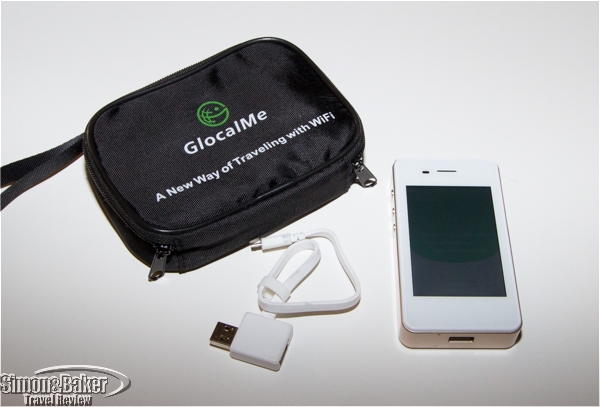
The RoamingMan WiFi device came with a charging cable and a zippered case.
Almost every device we travel with requires USB power to charge these days, and the charging cable had a pass through plug on the back, allowing multiple devices to charge from a single adapter. It performed double duty, as a WiFi hotspot and a standby battery pack for emergency charges, able to charge a cell phone or mp3 player in a pinch, a feature that came in handy a time or two.
RoamingMan rented the small Android based hub for a daily flat rate with unlimited data. The device we used was a customized version of the GlocalMe, with support provided by RoamingMan instead of the manufacturer. The WiFi hub used a cloud based SIM technology to allow global roaming, supposedly finding the best rate and connection, but what was critical to us is that it mostly worked well in South Africa. There was one day when we drove through the mountains in the Blyde River Canyon where reception was poor, but that was the exception. Connectivity was good in most places we tried.
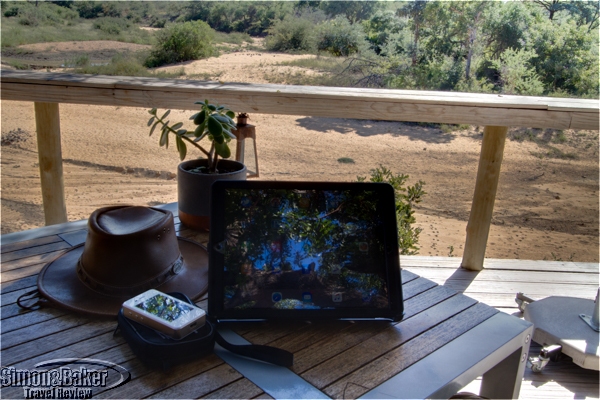
While sitting by the dry riverbed at The River Lodge I connected to the internet with the RoamingMan hotspot and my tablet
Delivery was of the hotspot unit stateside was efficient and convenient. The company shipped the device before we departed and activated it on the date we requested. When we returned home, we packed it into the shipping box, placed on the return label they provided and dropped it off a local UPS pickup spot. We were glad to have it with us, for the extra security of using cellular data without the challenges of figuring out the costs. This is one simple to use device that we will consider packing for future international adventures.



































